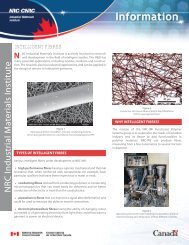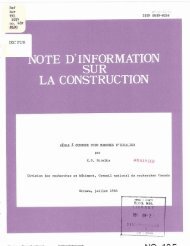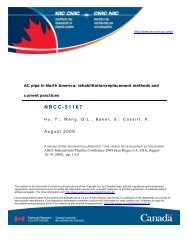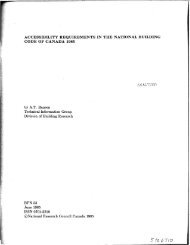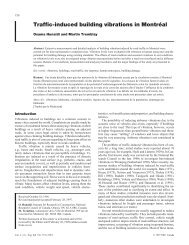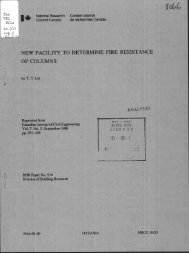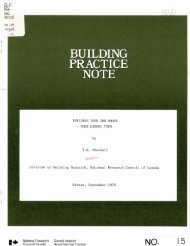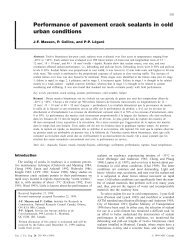Effect of Automatic Sprinkler Protection on Smoke Control Systems
Effect of Automatic Sprinkler Protection on Smoke Control Systems
Effect of Automatic Sprinkler Protection on Smoke Control Systems
Create successful ePaper yourself
Turn your PDF publications into a flip-book with our unique Google optimized e-Paper software.
LiP design = 0.05 in. H20 (12.5 Pa) in NFPA (1988)for z<strong>on</strong>ed smoke c<strong>on</strong>trol in sprinklered buildings(ceiling height < 9 ft [2.7 m]) is more than sufficientto prevent smoke movement, provided the door to thefire floor remains closed.6. Recommended practice for design <str<strong>on</strong>g>of</str<strong>on</strong>g> z<strong>on</strong>ed smokec<strong>on</strong>trol systems should allow for some airflow into thestairshaft to prevent the spread <str<strong>on</strong>g>of</str<strong>on</strong>g> smoke into thestairshaft if the door to the fire floor is opened.7. The assumpti<strong>on</strong> that smoke will never become a threatto life safety in a fully sprinklered building needs to hereexamined. The seriousness '<str<strong>on</strong>g>of</str<strong>on</strong>g> the hazard posed by ashielded fire should be assessed relative to the probability<str<strong>on</strong>g>of</str<strong>on</strong>g> occurrence <str<strong>on</strong>g>of</str<strong>on</strong>g> other impediments to sprinklerperformance, such as closed water supply valves.ACKNOWLEDGMENTSThis research was carried out as a joint research projectsupported by funding from the American Society <str<strong>on</strong>g>of</str<strong>on</strong>g> Heating,Refrigerating and Air-C<strong>on</strong>diti<strong>on</strong>ing Engineers, Inc.(ASHRAE), and the Nati<strong>on</strong>al Fire Laboratory (NFL),which is part <str<strong>on</strong>g>of</str<strong>on</strong>g> the Institute for Research in C<strong>on</strong>structi<strong>on</strong>,Nati<strong>on</strong>al Research Council Canada. Appreciati<strong>on</strong> is extendedto NFL technical <str<strong>on</strong>g>of</str<strong>on</strong>g>ficers D. Carpenter, R.A. MacD<strong>on</strong>ald,G. Crampt<strong>on</strong>, and M. Kanabus-Kaminska for theirwork in c<strong>on</strong>ducting the full-scale fire experiments and tostudent K. McCorvie <str<strong>on</strong>g>of</str<strong>on</strong>g> the Technical University <str<strong>on</strong>g>of</str<strong>on</strong>g> NovaScotia for her work in plotting the data.REFERENCESAlpert, R.L. 1984. Calculated interacti<strong>on</strong> <str<strong>on</strong>g>of</str<strong>on</strong>g> sprays withlarge-scale buoyant flows. Journal <str<strong>on</strong>g>of</str<strong>on</strong>g> Heat Transfer106: 310.Alpert, R.L., and M.M. Delichatsios. 1986. Calculatedinteracti<strong>on</strong> <str<strong>on</strong>g>of</str<strong>on</strong>g> water droplet sprays with plumes incompartments. Report NBS-GCR-86-520. Gaithersburg,MD: Nati<strong>on</strong>al Bureau <str<strong>on</strong>g>of</str<strong>on</strong>g> Standards.Alpert, R.L., and E.J. Ward. 1983. Evaluating unsprinkleredfire hazards. Technical Report 83-2. Bost<strong>on</strong>:Society <str<strong>on</strong>g>of</str<strong>on</strong>g> Fire <str<strong>on</strong>g>Protecti<strong>on</strong></str<strong>on</strong>g> Engineers.Battrick, P. 1986. Venting plus sprinklers-The caseagainst. Fire Internati<strong>on</strong>al, October/November, pp. 31-34.Chow, W.K. 1988. <str<strong>on</strong>g>Sprinkler</str<strong>on</strong>g>s in atrium buildings. H<strong>on</strong>gK<strong>on</strong>g Engineer, September, pp. 41-43.Chow, W.K. 1989. On the evaporati<strong>on</strong> effect <str<strong>on</strong>g>of</str<strong>on</strong>g> a sprinklerwater spray. Fire Technology 25(4): 364-373.Chow, W.K., and N.K. F<strong>on</strong>g. 1988. Cooling effect <str<strong>on</strong>g>of</str<strong>on</strong>g> afire-induced stratified hot air layer by sprinkler waterspray .. FireJournal, Australian Fire <str<strong>on</strong>g>Protecti<strong>on</strong></str<strong>on</strong>g> Associati<strong>on</strong>,June, pp. 20-27.Chow, W.K., and N.K. P<strong>on</strong>g. 1990. Numerical studies <strong>on</strong>the sprinkler fire interacti<strong>on</strong> using field modellingtechniques. Intetjlam '90, pp. 25-34, University <str<strong>on</strong>g>of</str<strong>on</strong>g>Kent, Canterbury, England.512Drysdale, D. 1985. An introducti<strong>on</strong> to fire dynamics, p.424. New York: John Wiley and S<strong>on</strong>s.Gardiner, A.J. 1988. The mathematical modeling <str<strong>on</strong>g>of</str<strong>on</strong>g> theinteracti<strong>on</strong>s between sprinkler sprays and the thermallybuoyant layers <str<strong>on</strong>g>of</str<strong>on</strong>g> gases from fires. Ph.D. dissertati<strong>on</strong>.L<strong>on</strong>d<strong>on</strong>: Council for Nati<strong>on</strong>al Academic Awards.Gustafss<strong>on</strong>, N.-E. 1989. <strong>Smoke</strong> ventilati<strong>on</strong> <str<strong>on</strong>g>of</str<strong>on</strong>g> sprinkleredcompartments. Proceedings <str<strong>on</strong>g>of</str<strong>on</strong>g> the Internati<strong>on</strong>al Fire<str<strong>on</strong>g>Protecti<strong>on</strong></str<strong>on</strong>g> Engineering Institute, IFPEI- V. Ottawa,ON: Society <str<strong>on</strong>g>of</str<strong>on</strong>g> Fire <str<strong>on</strong>g>Protecti<strong>on</strong></str<strong>on</strong>g> Engineers.Heskestad, G. 1974. Model study <str<strong>on</strong>g>of</str<strong>on</strong>g> automatic smoke andheat vent performance in sprinklered fires. FMRCReport, Serial No. 21933. Norwood, MA: FactoryMutual Research Corporati<strong>on</strong> (FMRC).Hinkley, P.L. 1989. The effect <str<strong>on</strong>g>of</str<strong>on</strong>g> smoke venting <strong>on</strong> theoperati<strong>on</strong> <str<strong>on</strong>g>of</str<strong>on</strong>g> sprinklers subsequent to the first. FireSafety Journal14: 221-240.Janssens, M.L. 1991. Measuring rate <str<strong>on</strong>g>of</str<strong>on</strong>g> heat release byoxygen c<strong>on</strong>sumpti<strong>on</strong>. Fire Technology 27(3): 234-249.Kaplan, H.L., and G.E. Hartzell. 1984. Modeling <str<strong>on</strong>g>of</str<strong>on</strong>g>toxicological effects <str<strong>on</strong>g>of</str<strong>on</strong>g> fire gases: 1. Incapacitatingeffects <str<strong>on</strong>g>of</str<strong>on</strong>g> narcotic fire gases. Journal <str<strong>on</strong>g>of</str<strong>on</strong>g> Fire Sciences2: 286-305.Kim, A.K., and G.D. Lougheed. 1990. The protecti<strong>on</strong> <str<strong>on</strong>g>of</str<strong>on</strong>g>glazing systems with dedicated sprinklers. Journal <str<strong>on</strong>g>of</str<strong>on</strong>g>Fire <str<strong>on</strong>g>Protecti<strong>on</strong></str<strong>on</strong>g> Engineering 2(2): 49-59.Klote, J.H. 1990. Fire experiments <str<strong>on</strong>g>of</str<strong>on</strong>g> z<strong>on</strong>ed smoke c<strong>on</strong>trolat the Plaza Hotel in Washingt<strong>on</strong> DC. NISTIR 90-4253. Gaithersburg, MD: Nati<strong>on</strong>al Institute <str<strong>on</strong>g>of</str<strong>on</strong>g> Standardsand Technology (NIST).Klote, J.H., and J.W. Fothergill, Jr. 1983. Design <str<strong>on</strong>g>of</str<strong>on</strong>g>smoke c<strong>on</strong>trol systems for buildings. NJJS Handbook141. Gaithersburg, MD: Nati<strong>on</strong>al Bureau <str<strong>on</strong>g>of</str<strong>on</strong>g> Standards(NBS).Klote, J.H., and J.A. Milke. 1992. Design <str<strong>on</strong>g>of</str<strong>on</strong>g> smokemanagement systems. Atlanta: American Society <str<strong>on</strong>g>of</str<strong>on</strong>g>Heating, Refrigerating and Air-C<strong>on</strong>diti<strong>on</strong>ing Engineers,Inc.Liu, S.T. 1977. Analytical and experimental study <str<strong>on</strong>g>of</str<strong>on</strong>g>evaporative cooling and room fire suppressi<strong>on</strong> bycorridor sprinkler system. Gaithersburg, MD: Nati<strong>on</strong>alBureau <str<strong>on</strong>g>of</str<strong>on</strong>g> Standards (Nati<strong>on</strong>al Institute <str<strong>on</strong>g>of</str<strong>on</strong>g> Standardsand Technology [NIST]).Madrzykowski, D., and R.L. Vettori. 1992. A sprinklerfire suppressi<strong>on</strong> algorithm for the GSA engineering fireassessment system. Gaith~rsburg, MD: U.S. Department<str<strong>on</strong>g>of</str<strong>on</strong>g> Commerce, Building and Fire ResearchLaboratory, Nati<strong>on</strong>al Institute <str<strong>on</strong>g>of</str<strong>on</strong>g> Standards and Technology(NIST).Mailvaganam, S., D. Yung, and M. Prencipe. 1992. Ontari<str<strong>on</strong>g>of</str<strong>on</strong>g>ire loss statistics for the risk-cost assessmentmodel. Internal Report No. 622. Ottawa, ON: Institutefor Research in C<strong>on</strong>structi<strong>on</strong>, Nati<strong>on</strong>al Research·Council <str<strong>on</strong>g>of</str<strong>on</strong>g> Canada.Mawhinney, J.R., D.W. Carpenter, R.A. MacD<strong>on</strong>ald, andG.T. Tamura. 1992. Experiments involving shielded,sprinklered fires in a building equipped with a z<strong>on</strong>edASH RAE Transacti<strong>on</strong>s: Research




